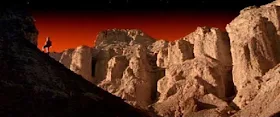Pages
▼
Friday, October 18, 2019
Robinson Crusoe on Mars (Byron Haskin, 1964)
Robinson Crusoe on Mars (Byron Haskin, 1964)
Cast: Paul Mantell, Victor Lundin, Adam West. Screenplay: Ib Melchior, John C. Higgins, based on a story by Daniel Defoe. Cinematography: Winton C. Hoch. Art direction: Arthur Lonergan, Hal Pereira. Film editing: Terry O. Morse. Music: Van Cleave.
The average third-grader today can spot the scientific inaccuracies of Robinson Crusoe on Mars. Who doesn't cringe when Christopher Draper (Paul Mantell) tries to start a fire by feeding the flames with the oxygen from his supply tank, an attempt most likely to send him up in a large fireball? The special effects, too, are primitive: The attacking spaceships are two-dimensional, paintings on a black backdrop. But does any of this really matter? With older films, even science fiction, datedness often counts for less than style and substance. Byron Haskin's movie has both, largely because it's derived from a classic source, Daniel Defoe's 1719 tale of solitude and companionship. It plays on the primal fear of loneliness that makes solitary confinement the worst of punishments and is the backbone of many classic adventure stories, including such other great sci-fi films as 2001: A Space Odyssey (Stanley Kubrick, 1968) and The Martian (Ridley Scott, 2015). Even though Draper has a companion on Mars, a small monkey, his inability to converse with another human drives him near to madness -- a hallucination of his dead companion, Col. McReady (Adam West) -- before he finally encounters his Friday (Victor Lundin). Even then the breakthrough is slow to come: The alien humanoid at first refuses to speak, causing Draper to fume that he's "an idiot" and "retarded." But finally the alien trusts Draper enough to speak and the rapport blooms into a kind of interplanetary bromance as they learn each other's language and culture. (The master-servant Crusoe-Friday relationship remains, however: Draper expects his Friday to learn English first. Colonialism dies hard.) So forget everything we've learned from the various NASA probes about Martian terrain -- the absence of flaming volcanoes or of anything resembling "canals," let alone abundance of water and subaqueous plant life -- and accept the movie's vision for what it is: more a fable about long-ingrained human character than about what the future may be like. Byron Haskin's direction keeps the action crisp and steady, and while the studio sets have a certain cheesy quality, the footage shot at Death Valley's Zabriskie Point is often strikingly real.
Charles Matthews
























